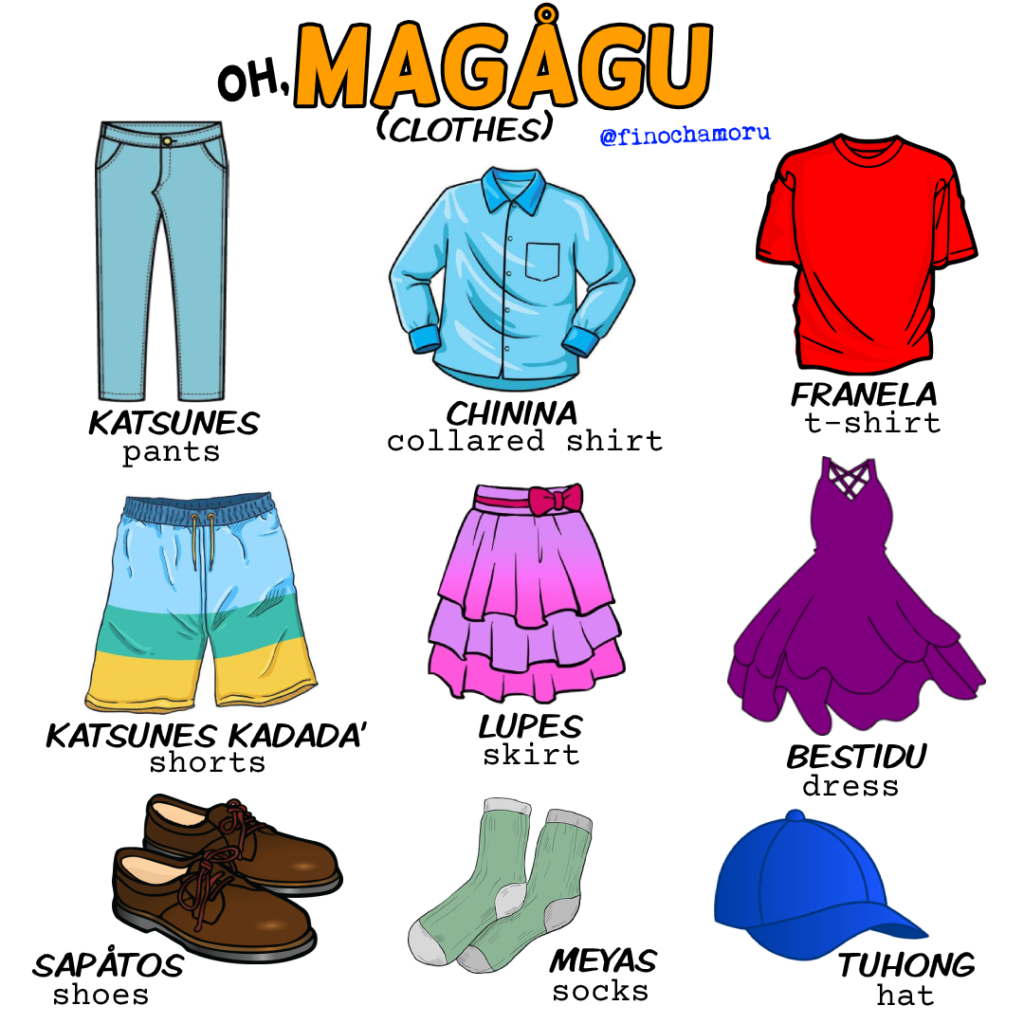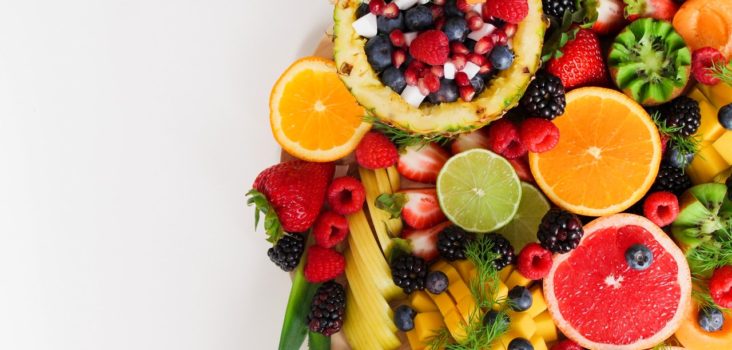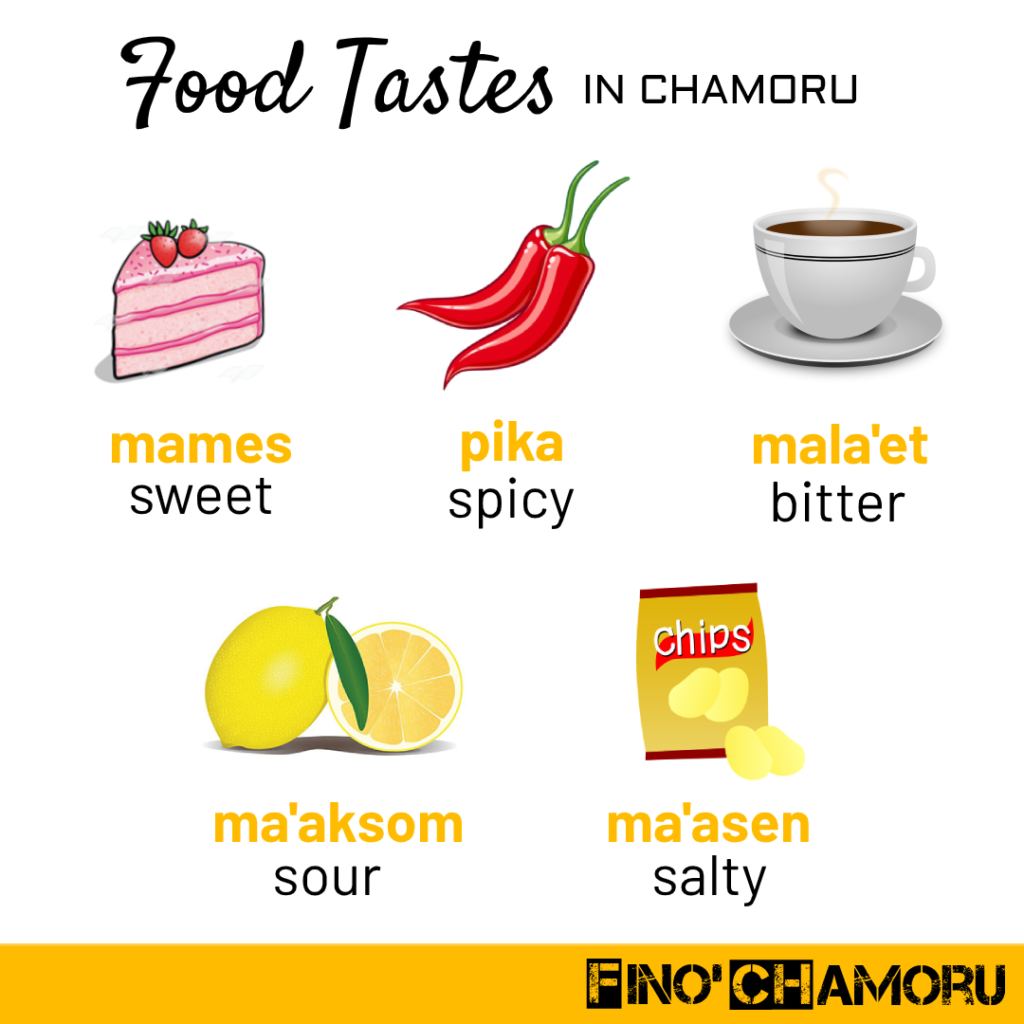September 23, 2020
Negation and Negative Words in Chamorro
In this article, we’ll learn Chamorro negation and negative words.
To make statements negative in Chamorro, in most cases, you simply have to put the negative marker ti at the beginning of the statement.
Look at the following examples.
| Ti båba este. This is not bad. |
| Ti ya-hu tumåtes. I don’t like tomatoes. |
| Ti manhanao ham para i lancho, sa’ u’uchan. We didn’t go to the ranch, because it’s raining. |
There are a couple of exceptions to this. The words guaha and gaige both have negative counterparts. They are tåya’ and taigue, respectively. So, instead of using ti we say these opposite words. Look at the following examples.
| Guaha chåda’ gi kahon ais. There are eggs in the refrigerator. | Tåya’ chåda’ gi kahon ais. There are no eggs in the refrigerator. |
| Guaha karetå-hu. I have a car. | Tåya’ karetå-hu. I don’t have a car. |
| Gaige i yabi-hu gi betså-hu. My keys are in my pocket. | Taigue i yabi-hu gi betså-hu. My keys are not in my pocket. |
| Gaige si George gi kuåtto-ña. George is in his room. | Taigue si George gi kuåtto-ña. George is not in his room. |
Negative Words
Using the negative marker ti is the most basic type of Chamorro negation, but you can also use the following negative words and phrases.
| ENGLISH | ENGLISH |
| munga | don’t |
| cha’-(poss. pron.) | don’t (even, try to) |
| ni | nor |
| ni…ni | neither…nor |
| ni ngai’an (ni ngai’a’an) | never / never ever |
| ni håyi (ni håyiyi) | no one / no matter who |
| ni håfa (ni håfafa) | none / no matter what |
| ni månu (ni månunu) | nowhere / no matter where |
| nunka | never |
| tampoku | neither, not either |
| trabiha | not yet |
Here are some examples using the negative words from the table above.
| Munga kumuentos. Don’t talk. |
| Ni si Antonia humånao. Neither Antonia went. |
| Ni unu ni otro! Not one nor the other! |
| Ni ngai’an bai hu maleffa. I will never forget. |
| Ti angokkuyon na taotao! Ni håyiyi un faisen. He’s not a trustworthy person! No matter who you ask. |
| Ti bai hu magof guini, ya ni hågu tampoku. I won’t be happy here, and neither will you. |
| Ti hu apåpåsi i dibi-hu trabiha. I haven’t paid my bills yet. |
September 21, 2020
Animal Names in Chamorro
This section covers the names and vocabulary used for gå’ga’, or animals, in Chamorro.
| Chamorro | English |
| ababang | butterfly |
| abeha | bee |
| agila | eagle |
| afula’ / fanihen tåsi | stingray, manta ray |
| apåcha’ | grasshopper |
| asuli | freshwater eel |
| ayuyu | coconut crab |
| babui | pig |
| baka | cow (female bovine) |
| bayena | whale |
| binådu | deer |
| buliku | donkey |
| chå’ka | rat, mouse |
| chiba | goat |
| dengdeng | snail |
| dulalas | dragonfly |
| elefante | elephant |
| fanihi | fruit bat |
| gåmson | octopus |
| ga’lågu | dog |
| guali’ek | gecko |
| guaka | cattle |
| gåyu | rooster |
| guihan | fish |
| haggan | turtle |
| halu’u | shark |
| hiraffa | giraffe |
| kabåyu | horse |
| kaiman | alligator |
| karabao | carabao, water buffalo |
| katu | cat |
| kulepbla | snake |
| kunehu | rabbit |
| lålo’ | housefly |
| lión | lion |
| lobu | wolf |
| loru | parrot |
| macheng | monkey |
| mahongang | lobster |
| månnok | chicken (fowl) |
| nosnos | squid |
| ñåtak | saltwater eel |
| ngånga’ | duck |
| ñåmu | mosquito |
| paluma | bird |
| påbu | turkey |
| punidera | hen |
| puyitos | chick (baby chicken) |
| obehas | sheep |
| osu | beer |
| otdot | ant |
| sanye’ye’ | spider |
| saligao | centipede |
| sasata | wasp |
| tigiri | tiger |
| toru | bull |
| tuninos | dolphin |
| uhang | shrimp |
| ulo’ | earthworm |
September 6, 2020
Clothing and Accessories

The general word for “clothes” in Chamorro is magågu. In this post, we’ll learn the various Chamorro terms for articles of clothing. At the end, we’ll include a brief lesson on how to say “wear”, so you can start using these words.
| chinina collared shirt franela t-shirt katsunes pants katsunes kådada’ short pants katsunes anakko’ long pants bestidu dress lupes skirt tråhi uniform, outfit saku suit, jacket | katsonsiyu men’s underwear pante’ panties kamisola underslip brasia bra meyas socks dogga footwear sapåtos shoes chankletas sandals yore’ flip-flops |
Clothing Accessories
Here are some words for adotnon magågu, or clothing adornments or decorations, to komplimento i trahi-mu, or complement your outfit.
| kotbåta | tie |
| alåhas | jewelry |
| kadena | chain, necklace |
| adotnon agå’ga’ | necklace, neckwear |
| alitos | earrings |
| aniyu | ring |
| putseras | bracelet |
| guåntes | gloves |
| sinturon | belt |
| anti’ohos | eyeglasses |
| tuhong | hat |
| paini | comb |
| paineta | decorative head comb |
| relos | watch |
| påñu | handkerchief |
Words to Describe Your Clothing
Here is a list of words that will come in handy when you want to describe your clothing. These include parts of your clothing, its condition, and the material its made out of.
| kueyu | collar |
| botsa | |
| båtunes | buttons |
| makalelu | wrinkled |
| åtgidon | cotton |
| låna | wool |
| kueru | leather |
| seda | silk |
How to say “wear” in Chamorro
In Chamorro, if we want to say “wear” an article of clothing, we use the word “usa”, which can also be used as a general word meaning “use”.
Bai hu usa bestidu agupa’.
I will wear a dress tomorrow.
Ti ya-hu manusa tuhong.
I don’t like wearing hats.
Another way to express “wear” in Chamorro is by using the affix in with an article of clothing. Study the following examples.
Håfa na ti minagågagu hao?
Why aren’t you dressed?
Ti ya-hu tinihong.
I don’t like wearing hats.
Ti sininturon yu’, sa’ ti siña hu sodda’ i sinturon-hu.
I didn’t wear a belt, because I couldn’t find my belt.
Lachaddek sinapatos! Siempre atrasao hit.
Put your shoes on quickly! We’re going to be late.
Other Chamorro verbs related to clothing
| muda | to change one’s clothes, to get dressed |
| mamuda | to have changed one’s clothes |
| chagi | to try on |
| dopbla | to fold |
| prensa | to iron |
| pula’ | to take off |
| fa’gåsi magågu | to wash clothes |

September 1, 2020
The Linking Particle na
The particle na is truly one of the most versatile particles in the Chamorro language. The following description below lists all the different ways in which na is used.
“Na” as a Noun Modifier
One of the most basic ways to use na is to connect an adjective with the noun it modifies.
Maolek na estudiante
A good student
Dånkolo na guma’
A big house
Agaga’ na kareta
A red car
“Na” as a General Modifier
Tres na sitbesa.
Three beers
Guiya na taotao ti ya-ña masangåni.
He’s a person who doesn’t like to be told.
Guaha na taotao ti yan-ñiha tumåtes.
Some people do not like tomatoes.
“Na” as a Conjunction
The particle na is used in the same way as the subordinating conjunction “that” in English. In conversational English, the conjunction “that” is often omitted, but in Chamorro, it must always be used.
Kao un tungo’ na magraduha si Jennifer?
Did you know that Jennifer graduated?
Maolek na matto hao.
It’s good that you came.
Hagas ha’ hu tungo’ na guiya.
I always knew that it was him.
The particle na can also be used in sentences where we would use “rather” or “but” in English. For example, one might say “It’s not blue, but red in color.” That is, the second clause corrects the initial negative.
Ti matuhok yu’ na yayas ha’ yu’.
I’m not sleepy, but just tired.
Ti ha fa’tinas, na ha fåhan gi tenda.
He didn’t make, but rather he bought it at the store.
Ti asut na betde.
It’s not blue, but green.
“Na” to ask a Negative Rhetorical Question
These are questions where we anticipate an affirmative answer.
Na ti hågu fumåhan i pan?
But weren’t you the one who bought the bread?
Na ti si Peter hao sumangåni?
But wasn’t Peter the one who told you?
July 21, 2020
Useful Words to Describe Food in Chamorro

In this post, we will take a look at some useful words you can learn to describe the food you eat in Chamorro. Maybe you’re eating a meal and you want to compliment and describe how some of the food tastes. The following are some basic adjectives we use to describe flavors.

In English, 5 basic tastes we use daily to describe food are: Sweet, Spicy, Bitter, Sour and Salty.
Here’s how to say and use each of these words in Chamorro:
mames
The Chamorro word mames is used describe something “sweet.” You can use this word to describe fruits or desserts.
Mames i kek.
The cake is sweet.
pika
Pika is the Chamorro word used to describe something “spicy.” You can use this word to say that your fina’denne’ is too spicy, because you added too many chili peppers. If you’re not into spicy, you may want to stay from the Chamorro dish kaddon pika.
Kåo pika i karí?
Is the curry spicy?
Ya-ña si Guadalupe pika na kelaguen.
Guadalupe likes spicy kelaguen.
mala’et
Mala’et is how you say “bitter” in Chamorro. You use it to describe your coffee or maybe certain vegetables.
Ti ya-ña si Lucio mala’et na nengkanno’.
Lucio does not like bitter food.
ma’aksom
Ma’aksom is the Chamorro word for anything that’s “sour” or “tangy.” You may use this to describe citrus fruits or pickled foods.
Ti ma’aksom i fina’denne’-ña.
Her fina’denne’ is not sour.
ma’asen
Ma’asen is the Chamorro word for “salty.”
Bula mampos na asiga un na’yi, sa’ gof ma’asen pa’go.
You’ve added too much salt, because it is very salty now.
Ma’asen i hanom tåsi.
Seawater is salty.
Other Useful Adjectives to Describe Food
Here are more useful words you can use to describe how food tastes, smells, feels and more!
månnge’ – delicious
matå’pang – bland, tasteless
paopao – fragrant
mutong – smelly, stinky
maipe – hot
manengheng – cold
ånglo’ – dry
fotgon – wet
fresko – fresh